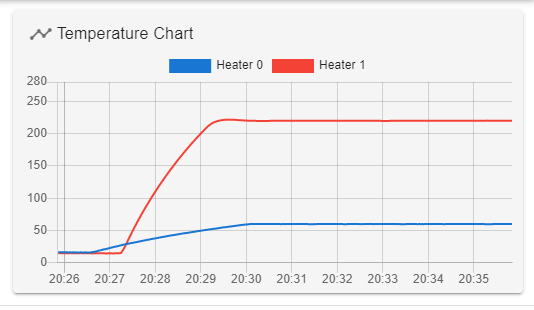Noisy/Fluctuating temperatures in idle since updating to RRF 3
-
@Phaedrux just checked, I had actually removed the config override entirely and had never used m500 as anything I wanted changing I have put in the config.
@Veti I will try this, I thought that's exactly how I tuned the PIDs anyway and did it fresh with RRF3.
Still not seeing why PID tuning is relevent to temperatures fluctuating around when idle, no attempt is being made to keep a certain temperature , it's just rapidly changing without input.
-
@MegaAndy said in Noisy/Fluctuating temperatures in idle since updating to RRF 3:
Still not seeing why PID tuning is relevent to temperatures fluctuating around when idle, no attempt is being made to keep a certain temperature , it's just rapidly changing without input.
you are right at idle pid tuning does not come into play.
have you calibrated your ADC?
https://duet3d.dozuki.com/Wiki/Calibrating_thermistor_and_PT1000_readings
-
@Veti I have not heard of calibrating ADC before but it does sound promising, a quick browse of the link you sent mentions gain which sounds like a likely culprit for a noisy signal.
I will see if I can get hold of a few resistors to work out the 100k for the H value and a 100. I'll report back once I have tried.
Strange I have the issue now when I didn't on RRF2. Only thing I can think of is I have not set it up or kept it at room temperature like I would have when setting up on RRF2, it's kept in a garage which when I checked it this morning was about 3 degrees!
-
for the semi auto calibration you only need a jumper. try that
-
@Veti oh great, I glanced at that and thought it was duet 3 only, yet another thing the maestro has over its duet 2 siblings!
-
@Veti Unfortunately , I have tried the semi automatic ADC tuning and have not seen any improvement. H value for both came up as 0 and L was either -1 or 1.
Interestingly, when I had a jumper over a thermistor , rather than getting a static reading, it was jumping all over the place from 2000c to 10953c. I would have thought this should be a static number. It reported a static -273c when the port was left open which I assume is correct.
Even the CPU temp looks like it's jumping around quite a lot so not sure if there is simply jitter on all sensor readings. (This is also visible on the video in the first post)
Video with a jumper over bed heater to show rapidly changing reading. Record_2020-12-31-14-14-18.mp4
-
ok that is not normal. i didnt even know it could go past 2000.
-
Looking like a hardware or wiring fault then I guess..
Found this from David on an old post: https://forum.duet3d.com/post/128645
I have measured 5v as a stable 4.9v and the 3.3v as stable 3.28v so I think that is ok. So could be one of the other things mentioned like leakage between bed heater and thermistor, I guess if that is the case it would be irreversible.
I guess at this stage the only way of proving it's not a config issue will be reverting back to old firmware with old configs to see if it still does it.
Edit: thought I should also mention that when I was setting up I couldn't get one fan working , on fan02, later realising the fan was just now not working as plugging another in worked fine. Makes me wonder if there was a surge at some point to cause this issue and break that fan at the same time.
-
Check your wiring for shorts.
-
I have done a bit of checking for shorts. One thing I have found is that ground and the VSSA pin of all of the thermistors are connected. I am guessing ground and VSSA should be separate?
They are also still joined after unplugging the thermistors.
Edit: Looks like according to this https://duet3d.dozuki.com/Wiki/Connector_and_spare_part_numbers#Section_VSSA_fuse , VSSA and the endstops ground should have under 5ohms between them, it reads 1.8ohm for me so looks correct.
-
I think I will just keep using it and see how it goes for now as I see no solution.
I have started a print and can see that despite the temperature seeming unstable at idle, when at temp it levels out to within 0.1 degrees of the requested temperature which is all that matters. I still also get a temperature blip when the bed is probed by the BL touch as shown in the graph below, reporting 15 degrees off within an instant.
It just seems to me that my printer in particular now seems more prone to noise/interference in temp readings than it was before.
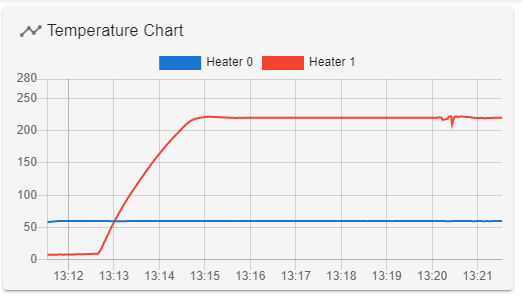
-
What's your wiring routing like?
Any possibly weak crimps? -
@Phaedrux The thermistors are just simply going to straight from the connectors to the hotend or bed.
All wires going to the X carriage are just simply bundled together though so I guess that is prone to interference. So I guess I should be insulating the thermistor wire from the bl touch and other wires. Weird that this could be causing an issue now after updating but no issue before though.
I used the connectors and crimps that came with the maestro but I wouldn't rule out me not crimping them well.

-
The routing looks no different than mine so I'm not sure it's the issue, but maybe there are some subtle differences.
If possible try and separate out the thermistor wires to see if it improves.
At least the temps seem stable when it matters.
-
@Phaedrux ok I will give that a go soon and see if I can see a difference.
I feel like if the measurement from shorting the thermistor with a jumper was fluctuating like mad instead of a static reading, shows that the noise/fluctuating issue is happening with the board rather than the thermistor wire.
And yes exactly main thing is they seem to be stable when at temp and not probing which is the important bit.
-
I am now tuning pressure advance again after retuning e-steps and find that this also causes my temperature to have massive amounts of fluctuations.
I am printing the pressure advance tuning found on this forum, its alternates between 5mm/s and 70mm/s in a straight line which is seeming to cause these temperature fluctuations. Presumably the extruder motor rapidly changing speeds is causing interference with the thermistor.
It's as if there used to be a filter for sensor noise but now any external factors are now causing havoc with the readings. Is there a setting anywhere for gain or noise compensation perhaps? I am wondering if there was a setting defaulted to on that now is not.
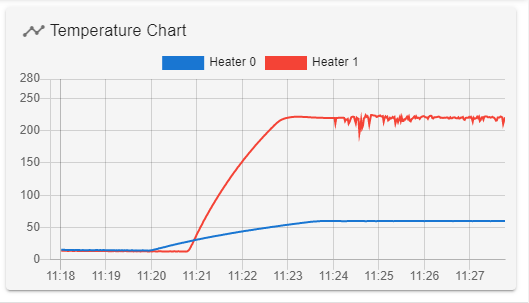
Once the calibration print was finished, the temp levelled out to requested temp and remained stable:
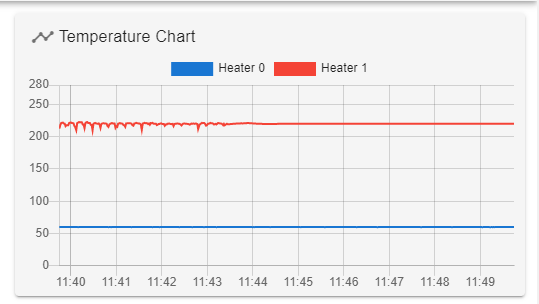
-
@MegaAndy
Can you try connecting the thermistor to second extruder input, just to see if its the same. -
@MegaAndy said in Noisy/Fluctuating temperatures in idle since updating to RRF 3:
Presumably the extruder motor rapidly changing speeds is causing interference with the thermistor.
Were you able to separate out the wiring?
-
@hackinistrator I have tried swapping the thermistor to the other extruder input and issue persisted.
Below chart shows that it starts spiking as soon as it starts probing, and is still fluctuating while just printing the slow first layer, then as soon as I pause you can see it smoothly levelling out, I then turn the heater off and it smoothly lowers.
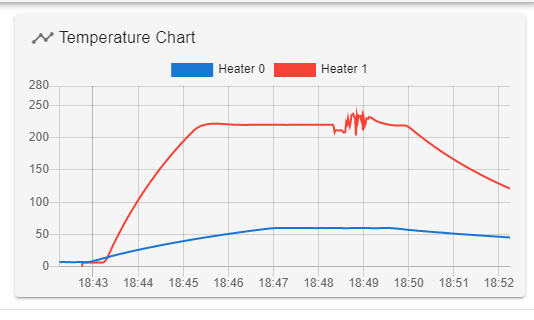
I will try separating wires as much as I can now and will report back.
-
@Phaedrux Ok so I might be there now!
I separated the wiring from the cable bundle going to the X carriage. I also had decided that while I was unbundling the wires I would replace the right cooling fan that seemed to have died when upgrading to RRF3. I could also see that I had just about fit the thermistor cable extension plug/socket in the gap behind the right fan. I went to check the crimps were ok and also insulate the bare (for a few mm) single core wire going into it with electrical tape but as it was pretty tight in there I managed to break the wire from the crimp. So I soldered the extension on and insulated the join instead and proceeded to test.
With the thermistor separated from the rest I got the below temp chart. There's was a wobble when homing but pretty much fine. I then restarted the print roughly bundling the wires up again with my hands to see if it would play up again and it was also fine.

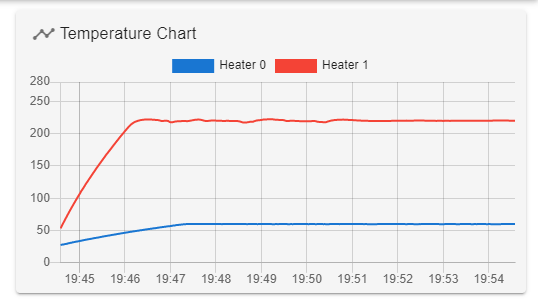
I have now rebundled all the wires again, and ran the print that would produce the issue every time. Below is the temp graph this time, perfect:
So I think this should be it solved for now but only time will tell using it properly to see if it comes back in certain situations! I do still think the fact that the temperature is jittering at low temps on all sensors doesn't seem normal though and I expect that must have still been related.
Anyway, thank you all for the help, especially @Phaedrux and @Veti, this community really is brilliant.
